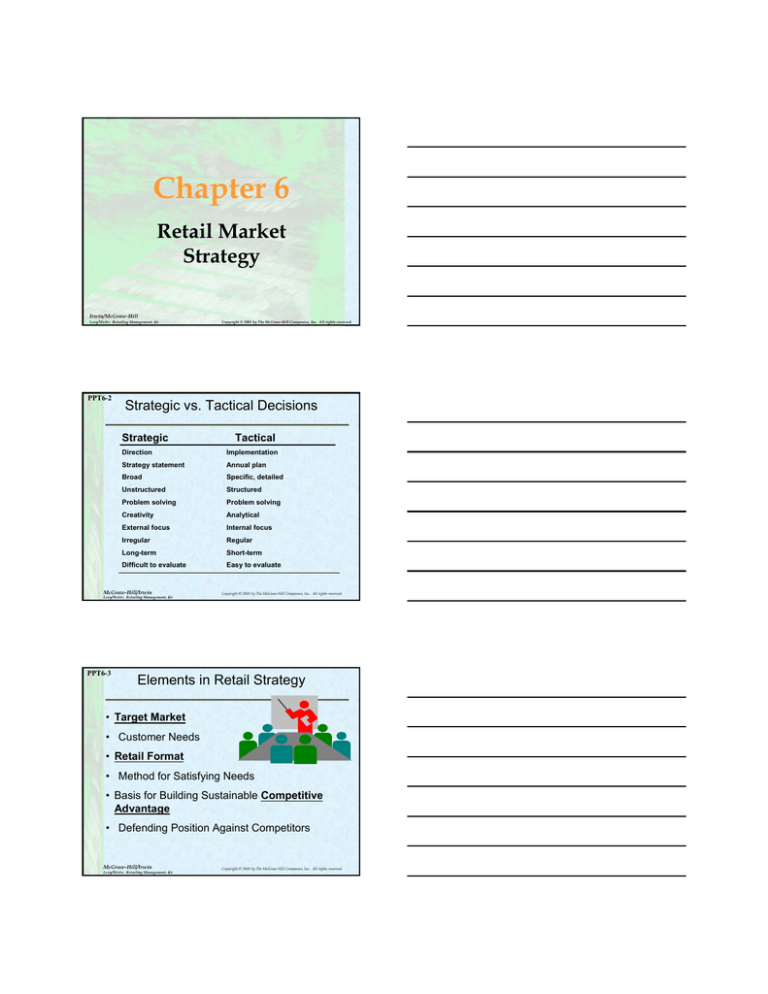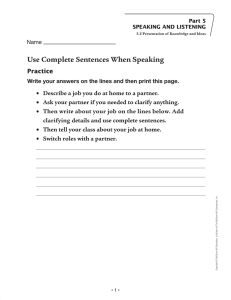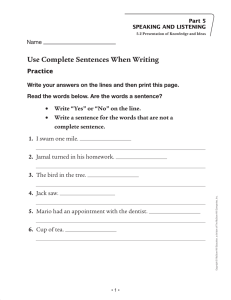
Chapter 6
Retail Market
Strategy
Irwin/McGraw-Hill
Levy/Weitz: Retailing Management, 4/e
PPT6-2
Strategic vs. Tactical Decisions
Strategic
Tactical
Direction
Implementation
Strategy statement
Annual plan
Broad
Specific, detailed
Unstructured
Structured
Problem solving
Problem solving
Creativity
Analytical
External focus
Internal focus
Irregular
Regular
Long-term
Short-term
Difficult to evaluate
Easy to evaluate
McGraw-Hill/Irwin
Levy/Weitz: Retailing Management, 4/e
PPT6-3
Copyright © 2001 by The McGraw-Hill Companies, Inc. All rights reserved.
Copyright © 2001 by The McGraw-Hill Companies, Inc. All rights reserved.
Elements in Retail Strategy
• Target Market
• Customer Needs
• Retail Format
• Method for Satisfying Needs
• Basis for Building Sustainable Competitive
Advantage
• Defending Position Against Competitors
McGraw-Hill/Irwin
Levy/Weitz: Retailing Management, 4/e
Copyright © 2001 by The McGraw-Hill Companies, Inc. All rights reserved.
PPT6-4
Why Does a Retailer Need to
Focus on a
Specific Target Market?
Why Not Sell to Everyone?
McGraw-Hill/Irwin
Levy/Weitz: Retailing Management, 4/e
PPT6-9
Copyright © 2001 by The McGraw-Hill Companies, Inc. All rights reserved.
Methods for Segmenting Markets
• Geographic
• Demographics
• Lifestyle, Psychographics
• Buying Situations
• Benefits Sought
McGraw-Hill/Irwin
Levy/Weitz: Retailing Management, 4/e
Copyright © 2001 by The McGraw-Hill Companies, Inc. All rights reserved.
Criteria For Selecting
A Target Market
PPT6-10
• Attractiveness -- Large, Growing,
Little Competition ===>Profitable,
• Consistent with Your Competitive
Advantages
McGraw-Hill/Irwin
Levy/Weitz: Retailing Management, 4/e
Copyright © 2001 by The McGraw-Hill Companies, Inc. All rights reserved.
PPT6-11
Can You Develop a Sustainable
Competitive Advantage by:
• Dropping the Price of Your Merchandise?
• Building a Store at the Best Location?
• Deciding to Sell Some Hot Merchandise?
• Increasing Your Level of Advertising?
• Attracting Better Sales Associates by Paying
Higher Wages?
• Providing Better Customer Service?
McGraw-Hill/Irwin
Levy/Weitz: Retailing Management, 4/e
PPT6-13
Copyright © 2001 by The McGraw-Hill Companies, Inc. All rights reserved.
Sources of Competitive Advantage
More Sustainable
• Location
• Customer Loyalty
• Low Cost Supply Chain
Management
Less Sustainable
• Better Computers
• More Employees
• More Merchandise
• Information Systems
• Greater Assortments
• Exclusive Merchandise
• Lower Prices
• Buying Power
• More Advertising
• Customer Service
• More Promotions
• Committed Employees
• How do strategy and tactics
relate here?
McGraw-Hill/Irwin
Levy/Weitz: Retailing Management, 4/e
PPT6-15
• Cleaner Stores
Copyright © 2001 by The McGraw-Hill Companies, Inc. All rights reserved.
Approaches for Building
Customer Loyalty
• Unique Positioning
• Customer Service
• Information About Customers (Database Retailing)
• Unique Merchandise
• Location
• With the possible exception of the last point, what
do all the above have in common?
McGraw-Hill/Irwin
Levy/Weitz: Retailing Management, 4/e
Copyright © 2001 by The McGraw-Hill Companies, Inc. All rights reserved.
PPT6-19
High Quality Customer Service
• Difficult to Achieve
• People Are Not Machines- - Inconsistent
• Retail Sales Associates At Bottom of Labor
Pool
• Goes Beyond Hiring Good People at High
Wages and Training Them- - Organizational
Culture
McGraw-Hill/Irwin
Levy/Weitz: Retailing Management, 4/e
PPT6-21
Copyright © 2001 by The McGraw-Hill Companies, Inc. All rights reserved.
Perceptual Map of
Women’s Apparel Market pg. 176
McGraw-Hill/Irwin
Levy/Weitz: Retailing Management, 4/e
PPT6-23
Copyright © 2001 by The McGraw-Hill Companies, Inc. All rights reserved.
Growth Opportunities
• Market Penetration; cross selling
• Market Expansion; Banana Republic
• Retail Format Development; B&N.com
• Diversification;
-
Related (Old Navy) vs. Unrelated (Target and
Dayton Hudson)
McGraw-Hill/Irwin
Levy/Weitz: Retailing Management, 4/e
Copyright © 2001 by The McGraw-Hill Companies, Inc. All rights reserved.
PPT6-24
International Growth Opportunities
• Europe
• China
• Mexico, Latin America
• Japan
McGraw-Hill/Irwin
Levy/Weitz: Retailing Management, 4/e
Copyright © 2001 by The McGraw-Hill Companies, Inc. All rights reserved.
Key to Success in
Global Retailing
PPT6-25
• Domestic market leadership
• Exploiting core competencies
– Low cost - Wal-mart, Carrefour
– Fashion Image - The Gap
– Category dominance - Toys ‘R’ Us
• Adaptability
• Global Systems
• Long
- term commitment
McGraw-Hill/Irwin
Levy/Weitz: Retailing Management, 4/e
PPT6-26
Copyright © 2001 by The McGraw-Hill Companies, Inc. All rights reserved.
International Market
Entry Strategies
• Direct investment (McDonalds Euro)
• Joint ventures (Wal Mart & CIFRA)
• Strategic alliances (local logistics)
• Franchising (Benetton)
McGraw-Hill/Irwin
Levy/Weitz: Retailing Management, 4/e
Copyright © 2001 by The McGraw-Hill Companies, Inc. All rights reserved.
Steps in the Strategic
Retail Planning Process pg. 189
PPT6-27
1. Define the business mission (point B)
2. Conduct a situation audit (point A):
Market attractiveness analysis
Competitor analysis
Self-analysis
3. Identify strategic opportunities
4. Evaluate strategic alternatives
5. Establish specific objectives and allocate resources
6. Develop a retail mix to implement strategy (tactics)
7. Evaluate performance and make adjustments
McGraw-Hill/Irwin
Levy/Weitz: Retailing Management, 4/e
PPT6-28
Copyright © 2001 by The McGraw-Hill Companies, Inc. All rights reserved.
Elements in a Market Analysis
1 00
80
60
40
20
0
1st Q tr
2 nd Qt r
3 r d Qt r
4t h Qt r
MARKET
FACTORS
Size
Growth
Seasonality
Business cycles
COMPETITIVE
FACTORS
ENVIRONMENTAL
FACTORS
ANALYSIS OF
STRENGTHS &
WEAKNESSES
Barriers to entry
Bargaining power of
vendors
Competitive rivalry
Threat of superior
new formats
Technology
Economic
Regulatory
Social
Management
capabilities
Financial resources
Locations
Operations
Merchandise
Store Management
Customer loyalty
17
McGraw-Hill/Irwin
Levy/Weitz: Retailing Management, 4/e
PPT6-32
Copyright © 2001 by The McGraw-Hill Companies, Inc. All rights reserved.
Steps in Using Market Attractiveness Competitive Position Matrix
• Define strategic opportunities
• Identify market attractiveness and competitive
position factors
• Assign weight based on importance of factors
• Rate opportunities on market attractiveness
and competitive position
• Calculate scores and evaluate opportunities
McGraw-Hill/Irwin
Levy/Weitz: Retailing Management, 4/e
Copyright © 2001 by The McGraw-Hill Companies, Inc. All rights reserved.
Questions for
Analyzing the Environment
PPT6-29
• New developments or changes- technologies, regulations, social factors,
economic conditions
• Likelihood changes will occur
• Key factors determining change
• Impact of change on retail market, firm,
competitors
McGraw-Hill/Irwin
Copyright © 2001 by The McGraw-Hill Companies, Inc. All rights reserved.
Levy/Weitz: Retailing Management, 4/e
Evaluation of Merchandise
Category Opportunities
High
Low
High
Soft home
Medium
667
z
z Men’s clothing
Women’s
clothing
z
Children’s
clothing
z
333
z
z
Furniture
Junior’s
clothing
1,000
McGraw-Hill/Irwin
Levy/Weitz: Retailing Management, 4/e
PPT6-36
Medium
Consumer
electronics
z
Low
Market Attractiveness
1,000
PPT6-41
667
333
Copyright © 2001 by The McGraw-Hill Companies, Inc. All rights reserved.
Evaluation of International
Growth Opportunities pg. 200
McGraw-Hill/Irwin
Levy/Weitz: Retailing Management, 4/e
Copyright © 2001 by The McGraw-Hill Companies, Inc. All rights reserved.





